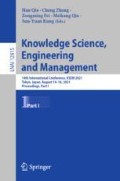Abstract
To examine the structural learning of the additive noise model in causal discovery, a new algorithm RCS (Rank-Correlation-Statistics) is proposed in combination with the rank correlation method. This algorithm can effectively process the multivariate linear Non-Gaussian data, and multivariate nonlinear non-Gaussian data. In this article, combined with hypothesis testing, a constraint method is proposed to select the potential neighbors of the target node, which greatly reduces the search space and obtains good time performance. Then the method is compared with the existing technology on 7 networks on the additive noise structure model. The results show that the RCS algorithm is superior to existing algorithms in terms of accuracy and time performance. Finally, it shows that the RCS algorithm has a good application on real data.
Access this chapter
Tax calculation will be finalised at checkout
Purchases are for personal use only
References
Yang, J., Guo, X., An, N.: Streaming feature-based causal structure learning algorithm with symmetrical uncertainty. J. Inf. Sci. 467, 708–724 (2018)
Bollen, K.A.: Structural Equations with Latent Variables. John Wiley, New York (1989)
Pearl, J.: Causality: Models, Reasoning, and Inference. Cambridge University Press, Cambridge (2000). singapore.cs.ucla.edu/BOOK-2K/
Heckerman, D., Mamdani, A., Wellman, M.P.: Real-world applications of Bayesian networks. J. Commun. ACM 38(3), 24–26 (1995)
Singh, M., Valtorta, M.: An Algorithm for the Construction of Bayesian Network Structures from Data. In: Uncertainty in Artificial Intelligence. Morgan Kaufmann, Washington D. C., pp. 259–265 (1993)
Friedman, N., Nachman, I., Peer, D.: Learning Bayesian network structure from massive datasets: the sparse candidate algorithm, In: Proceedings of the 15th International Conference on Uncertainty in Artificial Intelligence. Morgan Kaufmann Publishers, San Francisco, pp. 206–215 (1999)
Tsamardinos, I., Brown, L.E., Aliferis, C.F.: The max-min hill-climbing Bayesian network structure learning algorithm J. . Mach. Learn. 65(1), 31–78 (2006). https://doi.org/10.1007/s10994-006-6889-7
Schmidt, M., Niculescu-Mizil, A., Murphy, K.: Learning graphical model structure using L1-regularization paths, In: Proceedings of the Association for the Advancement of Artificial Intelligence, pp. 1278–1283 (2007)
Yang, J., Li, L., Wang, A.: A partial correlation-based Bayesian network structure learning algorithm under linear SEM. J. Knowl. Based Syst. 24(7), 963–976 (2011)
Yang, J., An, N., Alterovitz, G.: A partial correlation statistic structure learning algorithm under linear structural equation models. IEEE Trans. Knowl. Data Eng. 28(10), 2552–2565 (2016)
English, T.S., Ledwith, M.J., Davis, G.M.: The application of Bayesian networks to approximate the probability distribution of returns of equities. In: Proceedings of the IEEE Systems and Information Engineering Design Symposium, pp. 177–182 (2009)
Krizmaric, M., Mertik, M.: Application of Bayesian networks in emergency medicine. In: Proceedings of Central European Conference on Information and Intelligent Systems, Faculty of Organization and Informatics Varazdin, p. 1 (2008)
Chen, M., Zhang, Y., Qiu, M.: SPHA: smart personal health advisor based on deep analytic. IEEE Commun. Mag. 56(3), 164–169 (2018)
Cai, B., Liu, Y., Xie, M.: A dynamic-Bayesian-network-based fault diagnosis methodology considering transient and intermittent faults. IEEE Trans. Autom. Sci. Eng. 14(1), 276–285 (2016)
Shimizu, S., Inazumi, T., Sogawa, Y.: DirectLiNGAM: a direct method for learning a linear non-Gaussian structural equation model. J. Mach. Learn. Res. 12, 1225–1248 (2011)
Hoyer, P.O., Janzing, D., Mooij, J.M.: Nonlinear causal discovery with additive noise models. J. Adv. Neural Inf. Process. Syst. 21, 689–696 (2008)
Tillman, R.E., Gretton, A., Spirtes, P.: Nonlinear directed acyclic structure learning with weakly additive noise models. In: Conference on Neural Information Processing Systems, pp. 1847–1855 (2009)
Zhang, K., Peters, J., Janzing, D.: Kernel-based conditional independence test and application in causal discovery. arXiv preprint: arXiv:1202.3775 (2012)
Hu, S., Chen, Z., Nia, V.P.: Causal inference and mechanism clustering of a mixture of additive noise models. arXiv preprint: arXiv:1809.08568 (2018)
Huang, B., Zhang, K., Zhang, J.: Causal discovery from heterogeneous/nonstationary data with independent changes. arXiv e-prints: arXiv:1903.01672 (2019)
Zar, J.H.: Significance testing of the Spearman rank correlation coefficient. J. Am. Stat. Assoc. 67(339), 578–580 (1972)
Gai, K., Qiu, M.: Reinforcement learning-based content-centric services in mobile sensing. IEEE Netw. 32(4), 34–39 (2018)
Li, C., Qiu, M.: Reinforcement Learning for Cyber-Physical Systems: with Cybersecurity Case Studies. CRC Press, Boca Raton (2019)
Qiu, M., Jiang, Y., Dai, W.: Cost minimization for heterogeneous systems with Gaussian distribution execution time. In: 2015 IEEE 17th International Conference on High Performance Computing (2015)
Author information
Authors and Affiliations
Editor information
Editors and Affiliations
Rights and permissions
Copyright information
© 2021 Springer Nature Switzerland AG
About this paper
Cite this paper
Yang, J., Fan, G., Xie, K., Chen, Q., Wang, A. (2021). Additive Noise Model Structure Learning Based on Rank Statistics. In: Qiu, H., Zhang, C., Fei, Z., Qiu, M., Kung, SY. (eds) Knowledge Science, Engineering and Management. KSEM 2021. Lecture Notes in Computer Science(), vol 12815. Springer, Cham. https://doi.org/10.1007/978-3-030-82136-4_11
Download citation
DOI: https://doi.org/10.1007/978-3-030-82136-4_11
Published:
Publisher Name: Springer, Cham
Print ISBN: 978-3-030-82135-7
Online ISBN: 978-3-030-82136-4
eBook Packages: Computer ScienceComputer Science (R0)

